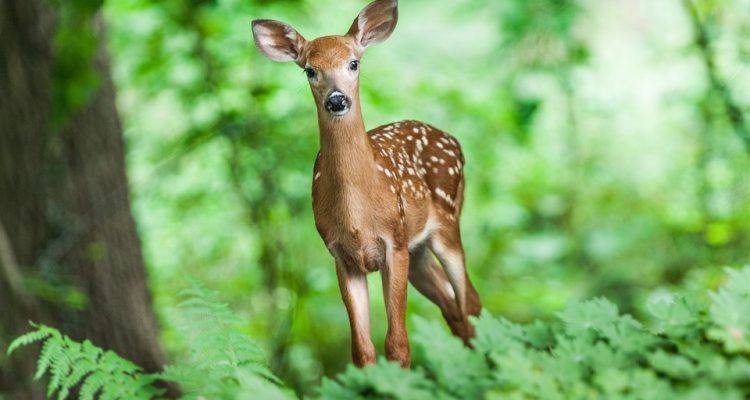The first time I meet her, something comes over me. I’m compelled to approach her. She looks soft and kind, yet hesitant. I’ve been told to stay away from her—friends tell me she’s trouble. But I can’t help myself. The luminous brown eyes, the delicate bone structure—I’m drawn in despite the warnings in my head. Don’t do this, a voice says. You’ll be sorry. But I’m in a trance. I extend my hand and she flinches. “Come on,” I whisper. “It’s okay.” Suddenly, she gives in, and her petite mouth is in my hand, accepting my offered gift.
Now, she’s always here, mooching. She won’t leave. She brings her friends. They party on the lawn all night long and leave a mess when they go. My gardens cry themselves to sleep at night and remember the days when buds blossomed into flowers and tomatoes grew full and red in the August heat.
And I have only myself to blame. I hand-fed a Honeycrisp apple to a white-tailed deer and now the rotten little tulip-muncher thinks she’s ours. What do you call a deer that eats out of your hand? A pet.
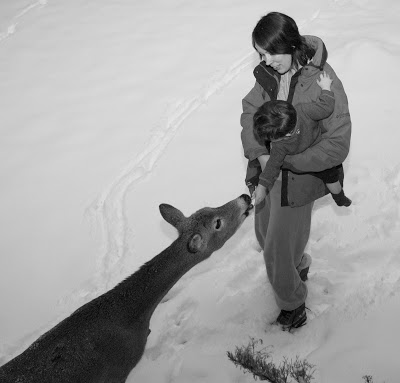
No West Virginia critter series would be complete without a piece on the varmint-iest of varmints: the white-tailed deer. I could spend a few paragraphs telling you that they’re a mid-sized ungulate spread across North America and that they have four stomachs, blah blah blah…let’s cut to the chase, shall we? These delinquents run us ragged. We build fences; they jump them. We apply deer-repellant; they eat the flowers anyway. We leave the dog outside; they laugh in the schnauzer’s face.
Every time I go to Nicky’s Garden Center and ask what I can plant that’s deer-proof, they gently tell me that deer will eat almost anything. That’s part of why deer are so successful. In times of scarcity, they’ll eat twigs, bark, and poison ivy. They’ve been observed consuming nestling songbirds, even.
Yikes.
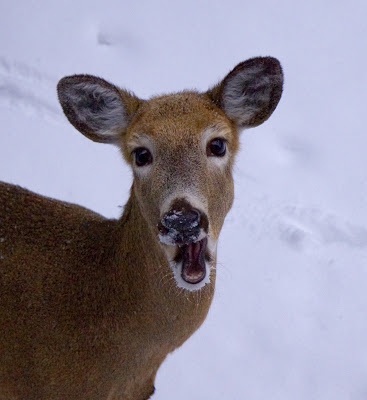
Another reason that deer are so abundant here has everything to do with our presence. White tails naturally thrive in borderlands. Centuries ago they hovered on the edge of the forest, between thick tree cover and open meadow. While the meadow offered food, the woods offered shelter and safety. A perfect balance.
Fast forward to today. Humans killed off all the eastern apex predators like wolves and mountain lions, so deer safety is no longer a concern. And when it comes to borderlands, what environment could suit a deer more perfectly than Wheeling, West Virginia? The suburbs. Plentiful, thick, forested hillsides give way to quiet neighborhoods. Dogs are fenced, guns are holstered, and the carefully-tended buffet line stretches as far as the ungulate eye can see. Truly, we’ve created a habitat that no deer could reject. Food, shelter, and safety. Welcome home, white-tail.
Home for a deer isn’t very big—about one square mile. Year after year, I see the same family. Deer don’t travel far. My yard is their yard, and they spend their lives in this small parcel of territory. Older deer learn to be cautious about traffic. You’ll see them hesitate on the side of the road before crossing, while young deer and fawns often pay the ultimate price for their inexperience. As you’ll surely tell me in the comments, deer can jump over eight feet, and your gardens aren’t safe. They eat about seven pounds of food each day and if they can find it on your deck, they’ll happily climb a few stairs to reach your container garden.
Many suburbanites feed them. While we cannot prevent them from eating out of our bird feeders, leaving corn for the deer does more harm than good. It can make them gravely ill, and a new food source lures in more deer to populated areas. Assembled around the corn feeder, they’re more likely to spread disease to one another.
On their own, deer have plenty of adaptations that give them an edge, including vision. It’s unclear exactly what deer can see, but their vision is nothing like ours. Their eyes are made to scan the horizon for predators—wide angled, focusing on distant points. They see movement, but probably not shapes or the color spectrum we do. What’s more, the deer-in-headlights idiom isn’t just an idiom. Because a deer eyeball contains more rods than cones, they simply cannot see in bright light. It’s not fear registering on their faces; it’s confusion. Bright light overwhelms their visual cortices and their brains lock down. White-tailed deer are crepuscular, meaning they’re most active at dawn and dusk. Accordingly, their eyes function best at corresponding light levels.
One-hundred years ago, the deer population in North America totaled only about one million due to unregulated hunting. Today, thanks to the cozy, suburban lifestyle we’ve afforded them, white-tailed deer number over 30 million. And at least seven of them—including Sweet Pea the apple-eater—live in my backyard. Most winter nights, a group of moms and youngsters bed down in the grass behind the house. During the warm summer weather, they browse their way through my shrubs. One winter day, this yearling stared in the window at me as I sat on the toilet while his siblings cleaned out my birdfeeder.
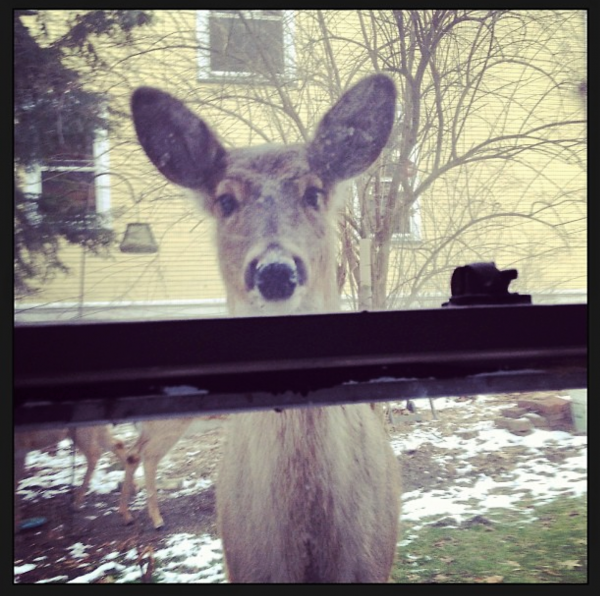
So, what are we supposed to do about this varmint problem? Their high numbers aren’t good for our dahlias (or our privacy), but more importantly, the excessive deer population is damaging the eastern hardwood forest. Certain species of trees are failing to thrive; in many cases they never make it past knee-height. Trilliums, my favorite spring ephemeral, don’t recolonize an area of the forest after deer damage, and due to deer’s extensive herbivory, songbird populations are declining as well. In fact, in many areas of the east, the rejuvenating effects of fire have largely been negated by the deer because there’s simply nothing left down low to burn.
Though disease and harsh winters will thin out deer numbers, 30 million is a big population. The West Virginia DNR designates deer seasons for firearms and bows, for bucks and antlerless deer. (Weasel season begins in November, by the way, and if you’re itching to skewer a wild boar, the fun starts in October.) Here in Wheeling, the city organizes an annual, urban bow hunt to help control the population. The limit is seven, with no more than two antlered deer. All hunting must be a minimum of 300 feet from any dwellings. And while hunting doesn’t solve the overpopulation problem, it does help, moreso from the taking of does than bucks.
When I was a kid, we only saw deer in Canaan Valley. I remember my mom shouting and my dad slamming on the brakes so we could observe a lone white-tail standing on the golf course by the resort. Now, I yell at them. I stamp my feet. “Beat it!” I shout into the yard, even at Sweet Pea. Usually, they stamp their own feet, raise their tails (both behaviors that warn other deer), and saunter away. One doe has begun to challenge my German shepherd. She snorts and snarfs and stands her ground. With the reintroduction of elk into southern West Virginia, I can’t help but wonder what will be bugling on the lawn in 30 years.
Why did I approach Sweet Pea that day with the apple? Maybe I was curious; maybe I was taken with her delicate face. Maybe the trauma of Bambi’s mother’s death left a scar. But in the moment when she came to me, Sweet Pea was a beautiful soul and I was so touched to have earned her trust.
Then she pooped on my deck.
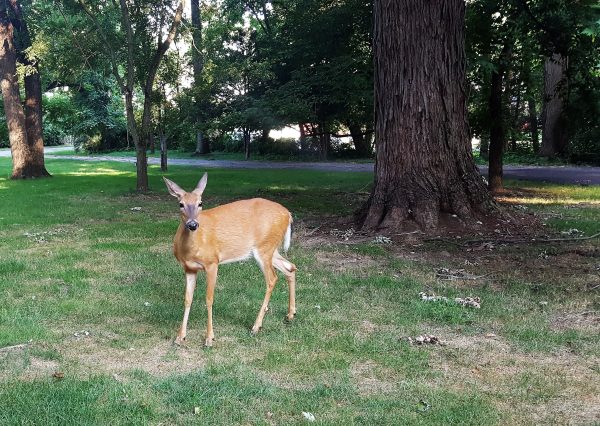
White-tailed deer infuriate me. I work so hard on my plantings. I spend hundreds of dollars each summer on various deer repellants. I’ve zapped myself with my own electric fence (you’ve got to ground that sucker, people), and one year I hooked up a hose to a motion sensor so I could blast them with a shot of cold water when they walked by. (Not only did it fail, but the mailman has never forgiven me.) They just keep coming, and you’ve got to admit that they rival humans for the title of “most adaptable creature.”
Varmints always do.
But I just can’t hate them. My heart skips a beat when our does bring their newborn fawns to the yard for the first time. We mourn as a family when the police come to put an unfortunate individual out of its misery on the National Road. Deer are gentle creatures. And while I rage harder than most when I see the pitiful, naked stalks of my hosta, I have to remember that I’m the one who planted that delicious treat. The deer simply don’t understand. It’s in their territory and it’s tasty. The huge rise in their numbers over the last 150 years is entirely our doing. We created this backyard menace.
Now, they’re here to stay.


